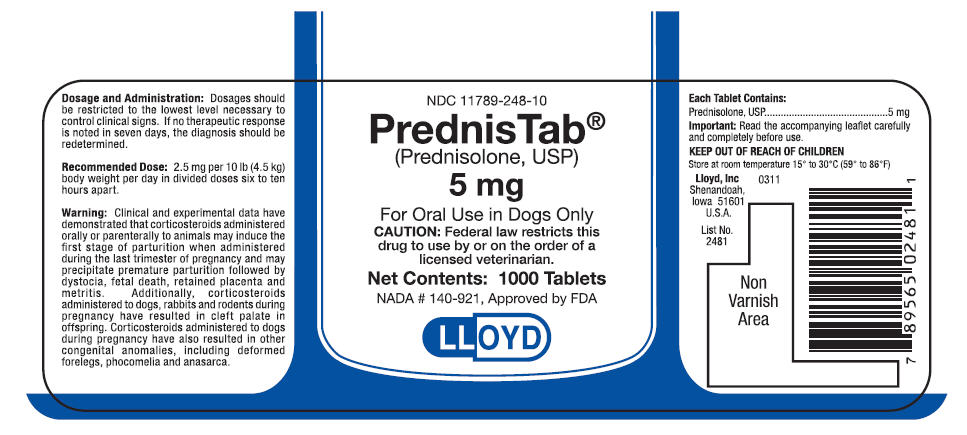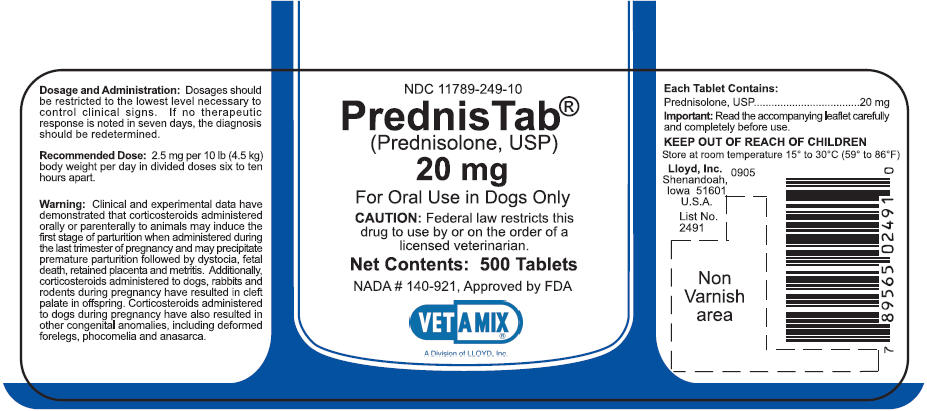DESCRIPTION
Prednisolone, like methylprednisolone, is a potent anti-inflammatory steroid. Prednisolone, 11,17,21-trihydroxypregna-1,4-diene-3,20-dione, is a synthetic dehydrogenated analogue of cortisone. Prednisolone and methylprednisolone have a greater anti-inflammatory potency and less tendency to induce sodium and water retention than the older corticoids, cortisone and hydrocortisone. The relative anti-inflammatory potency for hydrocortisone is 1.0; cortisone is 0.8; prednisolone is 4 and methylprednisolone is 5. The relative sodium retaining potency for hydrocortisone is 4; prednisolone is 3 and methylprednisolone is 2.1,2
INDICATIONS
PrednisTab is intended for use in dogs. The indications for PrednisTab are the same as those for other anti-inflammatory steroids and comprise the various collagen, dermal, allergic, ocular, otic, and musculoskeletal conditions known to be responsive to the anti-inflammatory corticosteroids. Representative of the conditions in which the use of steroid therapy and the benefits to be derived therefrom have had repeated confirmation in the veterinary literature are: (1) dermal conditions, such as nonspecific eczema, summer dermatitis, and burns; (2) allergic manifestations, such as acute urticaria, allergic dermatitis, drug and serum reactions, bronchial asthma, and pollen sensitivities; (3) ocular conditions, such as iritis, iridocyclitis, secondary glaucoma, uveitis, and chorioretinitis; (4) otic conditions, such as otitis externa; (5) musculoskeletal conditions, such as myositis, rheumatoid arthritis, osteoarthritis, and bursitis; (6) various chronic or recurrent diseases of unknown etiology such as ulcerative colitis and nephrosis.
In acute adrenal insufficiency, prednisolone may be effective because of its ability to correct the defect in carbohydrate metabolism and relieve the impaired diuretic response to water, characteristic of primary or secondary adrenal insufficiency. However, because this agent lacks significant mineralocorticoid activity, hydrocortisone sodium succinate, hydrocortisone, or cortisone should be used when salt retention is indicated.
CONTRAINDICATIONS
Do not use in viral infections. Prednisolone, like methylprednisolone, is contraindicated in animals with peptic ulcer, corneal ulcer, and Cushingoid syndrome. The presence of diabetes, osteoporosis, predisposition to thrombophlebitis, hypertension, congestive heart failure, renal insufficiency, and active tuberculosis necessitates carefully controlled use. Some of the above conditions occur only rarely in dogs but should be kept in mind.
CAUTION
Because of its inhibitory effect on fibroplasia, prednisolone may mask the signs of infection and enhance dissemination of the infecting organism. Hence, all animal patients receiving prednisolone should be watched for evidence of intercurrent infection. Should infection occur, it must be brought under control by use of appropriate antibacterial measures, or administration of prednisolone should be discontinued.
Warning
Not for human use. Clinical and experimental data have demonstrated that corticosteroids administered orally or by injection to animals may induce the first stage of parturition if used during the last trimester of pregnancy and may precipitate premature parturition followed by dystocia, fetal death, retained placenta, and metritis.
Additionally, corticosteroids administered to dogs, rabbits, and rodents during pregnancy have resulted in cleft palate in offspring. Corticosteroids administered to dogs during pregnancy have also resulted in other congenital anomalies, including deformed forelegs, phocomelia, and anasarca.
PRECAUTIONS
Prednisolone, like methylprednisolone and other adrenocortical steroids, is a potent therapeutic agent influencing the biochemical behavior of most, if not all, tissues of the body. Because this anti-inflammatory steroid manifests little sodium-retaining activity, the usual early sign of cortisone or hydrocortisone overdosage (i.e., increase in body weight due to fluid retention) is not a reliable index of overdosage. Hence, recommended dose levels should not be exceeded, and all animal patients receiving prednisolone should be under close medical supervision. All precautions pertinent to the use of methylprednisolone apply to prednisolone. Moreover, the veterinarian should endeavor to keep informed of current studies of corticosteroids as they are reported in the veterinary literature.
Use of corticosteroids, depending on dose, duration and specific steroid, may result in inhibition of endogenous steroid production following drug withdrawal. In patients presently receiving or recently withdrawn from systemic corticosteroid treatments, therapy with a rapid-acting corticosteroid should be considered in unusually stressful situations.
ADVERSE REACTIONS
Prednisolone is similar to methylprednisolone in regard to kinds of side effects and metabolic alterations to be anticipated when treatment is intensive or prolonged. In animal patients with diabetes mellitus, use of prednisolone may be associated with an increase in the insulin requirement. Negative nitrogen balance may occur, particularly in animals that require protracted maintenance therapy; measures to counteract persistent nitrogen loss include a high protein intake and the administration, when indicated, of a suitable anabolic agent. Excessive loss of potassium, like excessive retention of sodium, is not likely to be induced by effective maintenance doses of prednisolone. However, these effects should be kept in mind and the usual regulatory measures employed as indicated. Ecchymotic manifestations in dogs may occur. If such reactions do occur and are serious, reduction in dose or discontinuance of prednisolone therapy may be indicated.
Side effects, such as SAP and SALT enzyme elevations, weight loss, anorexia, polydipsia and polyuria have occurred following the use of synthetic cortico-steroids in dogs. Vomiting and diarrhea (occasionally bloody) have also been observed. Cushing's syndrome in dogs has been reported in association with prolonged or repeated steroid therapy.
Since prednisolone, like methylprednisolone, suppresses endogenous adrenocortical activity, it is highly important that the animal patient receiving prednisolone be under careful observation, not only during the course of treatment but for some time after treatment is terminated. Adequate adrenocortical supportive therapy with cortisone or hydrocortisone, and including ACTH, must be employed promptly if the animal is subjected to any unusual stress such as surgery, trauma, or severe infection.
ADMINISTRATION
The keystone of satisfactory therapeutic management with PrednisTab prednisolone tablets, as with other steroid predecessors, is individualization of dosage in reference to the severity of the disease, the anticipated duration of steroid therapy, and the animal patient's threshold or tolerance for steroid excess. The prime objective of steroid therapy should be to achieve a satisfactory degree of control with a minimum effective daily dose.
The dosage recommendations are suggested average total daily doses and are intended as guides. As with other orally administered corticosteroids, the total daily dose of prednisolone should be given in equally divided doses. The initial suppressive dose level is continued until a satisfactory clinical response is obtained, a period usually of 2 to 7 days in the case of musculoskeletal diseases, allergic conditions affecting the skin or respiratory tract, and ocular inflammatory diseases. If a satisfactory response is not obtained in 7 days, reevaluation of the case to confirm the original diagnosis should be made. As soon as a satisfactory clinical response is obtained, the daily dose should be reduced gradually, either to termination of treatment in the case of acute conditions (e.g., seasonal asthma, dermatitis, acute ocular inflammations) or to the minimal effective maintenance dose level in the case of chronic conditions (e.g., rheumatoid arthritis). In chronic conditions, and in rheumatoid arthritis especially, it is important that the reduction in dosage from initial to maintenance dose levels be accomplished slowly. The maintenance dose level should be adjusted from time to time as required by fluctuation in the activity of the disease and the animal's general status. Accumulated experience has shown that the long-term benefits to be gained from continued steroid maintenance are probably greater the lower the maintenance dose level. In rheumatoid arthritis in particular, maintenance steroid therapy should be at the lowest possible level.
Important: In the therapeutic management of animal patients with chronic diseases such as rheumatoid arthritis, prednisolone should be regarded as a highly valuable adjunct, to be used in conjunction with, but not as replacement for, standard therapeutic measures.
DOSAGE
2.5 mg per 10 lb (4.5 kg) body weight per day. Average total daily oral doses for dogs as follows:
| 5 to 20 lb (2 to 9 kg) body weight | 1.25 to 5 mg |
| 20 to 40 lb (9 to 18 kg) body weight | 5 to 10 mg |
| 40 to 80 lb (18 to 36 kg) body weight | 10 to 20 mg |
| 80 to 160 lb (36 to 73 kg) body weight | 20 to 40 mg |
The total daily dose should be given in divided doses, 6 to 10 hours apart.
HOW SUPPLIED
PrednisTab is available as 5 mg compressed quarter-scored tablets in bottles of 1000 and 20 mg compressed quarter-scored tablets in bottles of 500.
References
- Liddle, G.W. 1958. Studies of structure-function relationship of steroids. II. The 6α– methylcorticosteroids. Metab. Clin. Exp. 7:405-415.
- Haynes, R.C., Jr. 1990. Adrenocorticotropic hor- mone; adrenocortical steroids and their synthetic analogs; inhibitors of the synthesis and actions of adrenocortical hormones. Pages 1431-1462 in A.G. Gilman et al, eds. The Pharmacologica Basis of Therapeutics. 8th Ed., Pergamon Press, Elmsford, New York.
PRINCIPAL DISPLAY PANEL - 5 mg Bottle Label
NDC 11789-248-10
Prednis Tab®
(Prednisolone, USP)
5 mg
For Oral Use in Dogs Only
CAUTION: Federal law restricts this
drug to use by or on the order of a
licensed veterinarian.
Net Contents: 1000 Tablets
NADA # 140-921, Approved by FDA
LLOYD

PRINCIPAL DISPLAY PANEL - 20 mg Bottle Label
NDC 11789-249-10
Prednis Tab®
(Prednisolone, USP)
20 mg
For Oral Use in Dogs Only
CAUTION: Federal law restricts this
drug to use by or on the order of a
licensed veterinarian.
Net Contents: 500 Tablets
NADA # 140-921, Approved by FDA
VET A MIX®
A Division of LLOYD, Inc.
